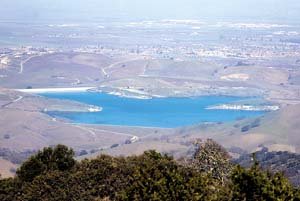They are just two tiny mussels but they are dealing a big hurt to California lakes and rivers.
Just ask Southern California’s biggest water district about the wrath of the quagga mussel, a dime-size mollusk that hitchhikes on boats and takes over its new environment by multiplying rapidly.
Quaggas appeared in Southern California five years ago. So far, the mollusks have cost the Metropolitan Water District $35 million for maintenance, chemicals, inspections and equipment. The mussel has now colonized 25 Southern California lakes.
Neither zebra or quagga mussels have gotten a Bay Area foothold – the closest discovery is in the Hollister area – but natural resource managers worry an invasion could be just a boat ride away by stowaway mollusks or larvae.
“It is frightening,” said Marty Grimes, a spokesman for the Santa Clara Valley Water District, part of a consortium of Bay Area water and recreation agencies working on a defenses against the mussels.
Although boaters are unhappy about the prospect, state lawmakers are considering a bill to double two-year boat registration fees – from $20 to $40 – to raise cash to fight off a mussel attack.
An invasion could hurt native fisheries, clog water pipes and boat engines, force up drinking water bills with higher operation costs, and ravage the base of the natural food chain in waterways from Lake Tahoe to Calero Reservoir near San Jose and Del Valle Reservoir near Livermore, say resource managers.
“Once you get the invasive mussels in your reservoirs, you can’t get rid of them,” said Charles Hardy, an East Bay Municipal Utility District spokesman.
The Sacramento San Joaquin River Delta, a nursery and migration path for salmon and many other fish, also is at risk, state environmental scientists said.
Workers at many lakes inspect boats to intercept quagga or zebras that might hitchhike on boat hulls or in pooled water aboard. But some operators don’t inspect boats due to the cost.
Boating groups say the state is moving too fast to collect higher fees from boat owners without knowing if it has the right defense plan.
“We recognize the mussels are a serious problem,” said Jack Michael, vice president of the board for the Recreational Boaters of California. “We are concerned this could be another example of government throwing money at a
problem without stepping back to make sure they have the best plan for how they use those monies.”
Michael said his group thinks it would be fairer to tap water districts for extra money because they represent a larger section of the population than do boaters.
Water and recreation officials say boats are the carriers that spread the mussels from place to place – much like mosquitoes carry malaria from person to person.
Some unknown boat likely brought the quagga to Lake Mead in 2007, where it then spread to 24 other state lakes.
Likewise, resource managers say a boat probably provided the ride in 2008 for the zebra mussel to reach and colonize San Justo Reservoir in San Benito County – the only state reservoir colonized by the zebra.
“We think this is a fairly minimal (boat) fee increase that could end up saving millions or billions of dollars,” said Jim O’Connor, an assistant general manger of the East Bay Regional Park District. “This is not just about boating, but about protecting the environment, our recreation lakes, and the water systems people rely on to get water.”
EBRPD and the Santa Clara County parks and recreation system charge a $7 fee to inspect boats entering a lake for the first time in a season. That fee, however, covers only a small fraction of inspection costs.
Lake Tahoe charges a boat inspection fee that starts at $33 for vessels up to 17 feet, $55 for boats between 17.1 and 21 feet, and more for bigger boats.
Some lake operators, however, charge nothing and do few inspections. Assembly Bill 2443, the proposed boat fee increase, would provide a stable source of funds to operate inspection programs and other measures to contain invasive muscles, says the bill author, Das Williams, D-Santa Barbara.
If it passes. water and recreation agencies could seek reimbursement for inspections.
“Unless there’s a comprehensive approach to prevention, the entire state remains threatened,” William’s office said in a statement.
Increasing the fee by $20 every two years for the state’s 800,000 registered boats could raise some $5 million to $8 million a year, officials estimated.
The fee would be set by the state Department of Boating Waterways after consulting an advisory committee that includes boaters. Many boaters may not have to pay the fees because the bill exempts boats used primarily in seawater.
Meanwhile, the freshwater quagga remains an unpleasant reason for higher costs at the Metropolitan Water District to prevent clogging equipment that moves drinking water to 19 million people.
“They are a significant and expensive hassle,” said Ricardo De Leon, a microbiologist at the water district. “I see preventing their spread as the way to go.”













